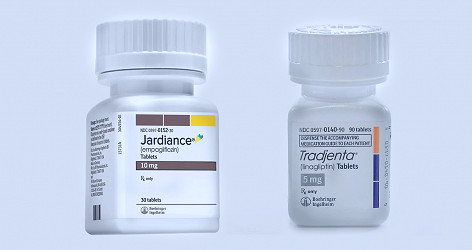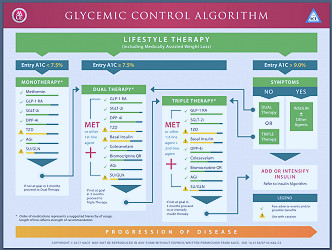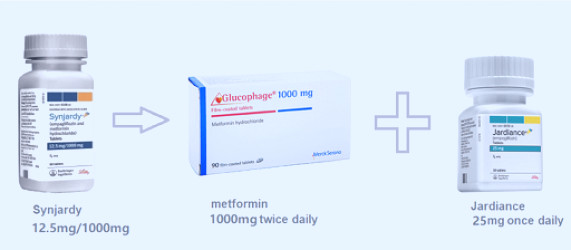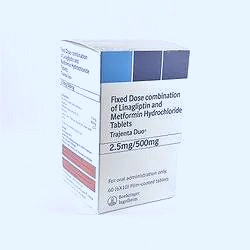
Comparative Analysis: Jardiance vs Tradjenta in Diabetes Treatment
Jardiance and Tradjenta are prescription medications used to manage Type 2 diabetes. Jardiance, also known as empagliflozin, helps regulate blood sugar levels by prompting the kidneys to get rid of more glucose from the body. Tradjenta, or linagliptin, works by increasing the levels of certain natural substances that lower blood sugar when it is high. Both medicines are oral tablets used in conjunction with a healthy diet and regular exercise to improve glycemic control in adults with type 2 diabetes.
Overview
Jardiance and Tradjenta: Jardiance (empagliflozin) and Tradjenta (linagliptin) are two popular medications used in the treatment of type 2 diabetes, a chronic condition that affects the way the body processes blood sugar (glucose). Both medications are developed by Boehringer Ingelheim, a leading global pharmaceutical company. Read more
Mechanism of Action
Jardiance works by inhibiting a protein called SGLT2 (Sodium-glucose co-transporter-2) in the kidneys. This leads to the excretion of excess glucose in the urine, thereby helping to lower blood sugar levels. On the other hand, Tradjenta inhibits the enzyme DPP-4 (Dipeptidyl peptidase-4), which increases the levels of incretin hormones in the body. These hormones help to regulate insulin production after meals and lower the amount of glucose produced by the liver. Read more
Efficacy and Safety
Both Jardiance and Tradjenta have been proven to be effective in managing blood sugar levels in adults with type 2 diabetes. However, they may cause side effects. Jardiance can cause dehydration, urinary tract infections, and genital yeast infections, while Tradjenta can cause pancreatitis, joint pain, and skin reaction. Read more
Cardiovascular Benefits of Jardiance
One unique feature of Jardiance is its demonstrated ability to reduce the risk of cardiovascular death in adults with type 2 diabetes and cardiovascular disease. This is an essential consideration for patients with diabetes, as the condition can increase the risk of heart disease. Read more

Renal Effects of Jardiance
In addition to its cardiovascular benefits, Jardiance has also been shown to slow the progression of kidney disease in patients with type 2 diabetes. This is because the medication helps to remove excess sugar from the blood, which can be harmful to the kidneys over time. Read more
Dosing and Administration
Tradjenta is typically taken once a day, regardless of meals. Jardiance, on the other hand, is usually taken once daily in the morning, before the first meal of the day. The dosages may vary depending on the patient's condition and response to the medication. Read more
Contraindications and Precautions
Both Jardiance and Tradjenta are contraindicated in patients with a history of hypersensitivity to the active substances or any of the excipients. Furthermore, Jardiance should not be used in patients with severe renal impairment, end-stage renal disease, or dialysis. Read more
Cost Considerations
Both Jardiance and Tradjenta can be expensive without insurance. However, many insurance plans, including Medicare and Medicaid, may cover these medications. Patients may also be eligible for savings programs or coupons from the manufacturer. Read more

Combination Therapy
Both Jardiance and Tradjenta can be used alone or in combination with other diabetes medications, such as metformin, to achieve better glycemic control. The choice will depend on the individual patient's needs, tolerance to the medication, and the doctor's recommendation. Read more
Conclusion
Jardiance and Tradjenta represent two different approaches to managing type 2 diabetes. Both have proven to be effective in controlling blood glucose levels, but they work in different ways and may have different side effects. Therefore, the choice between Jardiance and Tradjenta should be based on the individual patient's medical history, lifestyle, and personal preferences. Read more
Read more
 One Pill, One Co-pay: Combo Drug Glyxambi Now Available at Pharmacies Nationwide in the US
One Pill, One Co-pay: Combo Drug Glyxambi Now Available at Pharmacies Nationwide in the US Fate of Lilly's Jardiance franchise rests on FDA's delayed heart-benefits indication | Fierce Pharma
Fate of Lilly's Jardiance franchise rests on FDA's delayed heart-benefits indication | Fierce Pharma Entry of Cheaper Generic Versions of Jardiance and Tradjenta Temporarily Blocked In India – Myhealthyclick.com
Entry of Cheaper Generic Versions of Jardiance and Tradjenta Temporarily Blocked In India – Myhealthyclick.com GLYXAMBI® on PBS SGLT2i + DPP4i combination containing JARDIANCE® and TRAJENTA® • The Medical Republic
GLYXAMBI® on PBS SGLT2i + DPP4i combination containing JARDIANCE® and TRAJENTA® • The Medical Republic Boehringer and Lilly score FDA yes for Glyxambi - Pharmafile
Boehringer and Lilly score FDA yes for Glyxambi - Pharmafile University of Iowa Department of
University of Iowa Department of FDA Accepts sNDA for Jardiance in Children 10 to 17 with Diabetes
FDA Accepts sNDA for Jardiance in Children 10 to 17 with Diabetes Alternative Option to Face Synjardy and Jentadueto Supply Shortages | Canada Online Health
Alternative Option to Face Synjardy and Jentadueto Supply Shortages | Canada Online Health Alternative Option to Face Synjardy and Jentadueto Supply Shortages | Canada Online Health
Alternative Option to Face Synjardy and Jentadueto Supply Shortages | Canada Online Health T2D Treatment | Glyxambi® (empagliflozin/linagliptin tablets)
T2D Treatment | Glyxambi® (empagliflozin/linagliptin tablets) Is Jardiance generic available? - NiceRx
Is Jardiance generic available? - NiceRx Jardiance alternatives: which other diabetes medication can I take? - NiceRx
Jardiance alternatives: which other diabetes medication can I take? - NiceRx Tradjenta Duo 2.5 Mg / 1000 Mg Tablet, Boehringer Ingelheim, Prescription
Tradjenta Duo 2.5 Mg / 1000 Mg Tablet, Boehringer Ingelheim, Prescription What is GLYXAMBI (Empagliflozin/Linagliptin) used for? - Global Pharmacy
What is GLYXAMBI (Empagliflozin/Linagliptin) used for? - Global Pharmacy US FDA accepts supplemental New Drug Application for Jardiance® for children 10 years and older with type 2 diabetes
US FDA accepts supplemental New Drug Application for Jardiance® for children 10 years and older with type 2 diabetes Dosing Instructions | Trijardy® XR Tablets
Dosing Instructions | Trijardy® XR Tablets Tradjenta (linagliptin): Uses, Side Effects, Dosage & Reviews
Tradjenta (linagliptin): Uses, Side Effects, Dosage & Reviews US FDA approves only triple-combination tablet with Jardiance® for adults with type 2 diabetes
US FDA approves only triple-combination tablet with Jardiance® for adults with type 2 diabetes Trajenta | Diabetes Medication | Canada Online Health
Trajenta | Diabetes Medication | Canada Online Health Jardiance alternatives: which other diabetes medication can I take? - NiceRx
Jardiance alternatives: which other diabetes medication can I take? - NiceRx 



